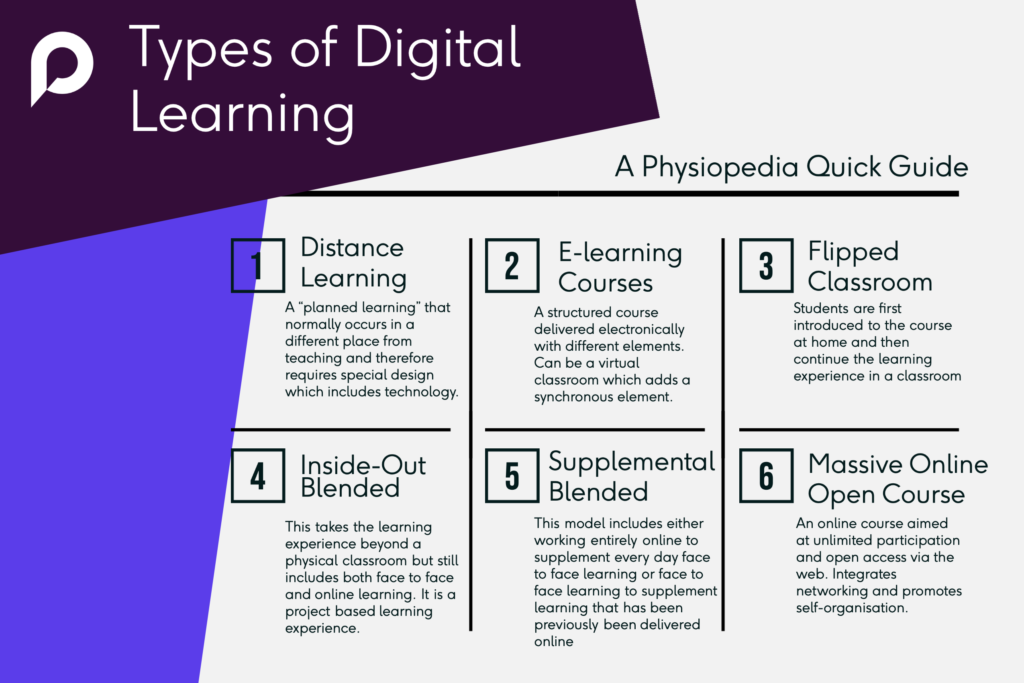Digital learning has the ability to transform physiotherapy education and more and more evidence is supporting it’s use. But what do RCTs tell us?
It seems counter intuitive doesn’t it, physiotherapy is a practical and hands on profession so how can you teach that using digital or distance learning methods? Well there is evidence to support and refute this argument. A systematic review by Rowe et al suggests it is an effective approach where as Evans et al disagree.
Whereas both these studies investigated healthcare professionals non-speicifically, a systematic review published in BMC Medical Education does. It compares the outcomes of physiotherapy students using classical / traditional approaches to digital learning methods.
Let’s explore this review in more detail and discuss the findings and implications of the results.
Methods
The systematic review adhered to PRISMA guidance and was pre-registered on PROSPERO, both hallmarks of methodologically sound systematic reviews.
Eight databases were searched for RCTs which investigated digital learning designs in physiotherapy education. If no RCTs were found then interrupted times and controlled trials would be included.
Articles would only be included if baselines and post education measures were included. The studies had to be written in English or a Scandinavian language. Examples of search terms used include:
‘assisted instruction/education’, ‘distance educational, technology/webcasts/information, technology/multimedia/computer, user training/world wide web, applications/computer simulation’, ‘blended’, ‘e-learning’, ‘m-learning’, ‘web-based’, ‘virtual’, ‘streaming’, ‘interactive’, ‘hybrid’, ‘gaming’, ‘massive open online course’, ‘flipped’ and ‘simulation’.
The full search strategy including all boolean operators and tailors searches for each data base is available in full.
Three reviewers independently screened the titles and abstracts and full-text review with disagreements resolved through consensus. Risk of bias was assessed using the Cochrone RoB tool.
To be included within the review articles had to:
- Study a population of physiotherapy students in an education programme
- Assess the learning outcomes of a digital learning design
- Compare the outcomes to traditional classroom learning
- Report students final marks or grades
Studies were excluded if they included less than half physiotherapy students, were aimed at training physio’s for work-life or where digital learning was not part of an explicit learning strategy.
The types of digital learning found within the articles is summarised below.
Results – Digital Learning is The Future
In total 22 studies with 2186 participants were included within the review. 17 of these studies involved undergraduate programmes, one MSc level and a single DPT programme.
There were articles from several countries including Australia (n=5), Spain (N=5), Brazil (N=3), Denmark (N=1) and USA (N=8). 17 were RCTs and 5 were cohort studies.
10 studies were eligible to be included within a meta-analysis and 12 were summarised narratively. All information is available in full within the free full text.
The results of this sytematic review demonstrate that digital learning probably more effective than classroom teaching for phyiotherapy education, both for knowledge and skill aquisition. The most common and most effective form of digital learning is likely flipped classroom. However there are challenges with interpreting this as there is no consistent definition of what flipped classroom is.
One of the stengths of digital learning is the emphasis of self-directed learning and enabling students to create their own content. This not only leads to better retainment of information but also more satisfaction and motivation. We are seeing this play out in clinical practice with the emergence of project based placements as part of the move to recoup lost clinical hours because fo the pandemic. We also see this at Physiopedia with the Content Development Projects.
Interactive website and apps also proved to be an effective method for teaching phyisiotherapy students and this was supported by the results of the meta-analysis. It’s likely that the reason for this is that students take control of their own learning and fit it around when they learn best. We see this in the feedback we recieve from Physioplus users.
In summary this systematic review shows significant effects on student learning in favour of the interventions using flipped classrooms, interactive websites/apps and students self-produced videos. However the caveat is that larger controlled studies are required to fully understand the nuances that result in improved learning outcomes.
Physioplus: The New Gold Standard of Digital Learning for Physiotherapists
Physioplus uses knowledge of digital learning to create the gold standard learning platform for physiotherapists. We are committed to meeting your needs through blended and remote learning strategies. Try now for FREE.
